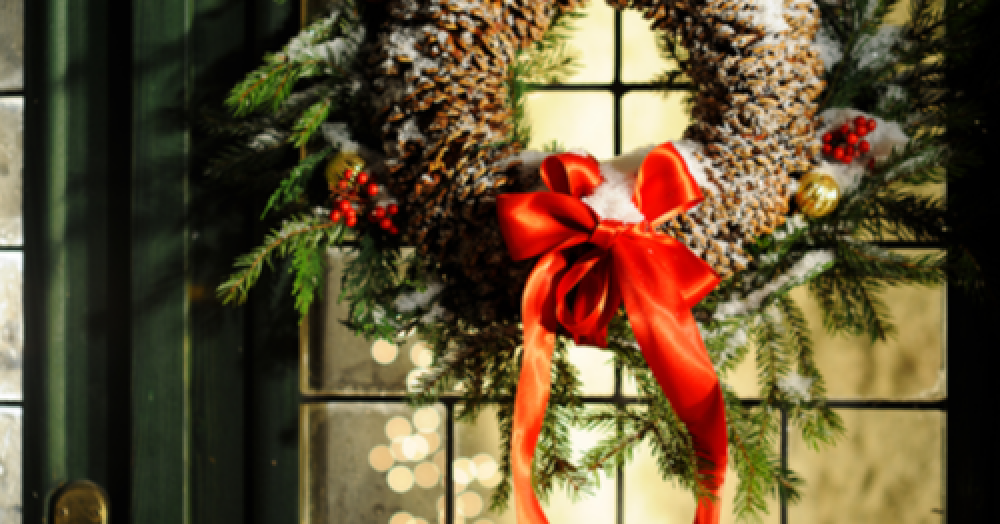
Deck your halls with the perfect period style decorations!
Using our guide, why not decorate your home for Christmas in proper historic detail?
ANY PERIOD: Spruce swags, garlands and wreaths “span the centuries,” so can be used in any age of property. Swags came from the pagan tradition of bringing living things inside in winter to celebrate new life coming. They borrowed this and the wreath, or “circle of life”, from classical imagery, and it then influenced Christian advent.
TUDOR/STUART: In your house with its low ceilings and dark beams, you would have celebrated the Festival of Midwinter, on December 21st. You’ll need lots of evergreens, boughs of holly, ivy, laurel and rosemary, which had mystical properties. Make large swags, garlands and a “kissing bough”, two overlapping hoops of foliage hung from the ceiling as if from a tree. Decorate these with oranges, nuts, ribbons and mistletoe.
You’ll also need a decorative centrepiece for the traditional “drunken, gluttonous feast”: a tart with “marchpane” (marzipan) decorated in gold leaf. You might want baskets of walnuts, pewter jugs, fruit and candles, taking inspiration from period paintings. An ash “yule log”, wrapped in hazel twigs, should be put in the fireplace on Christmas Eve, to burn for 12 days. If your home dates from 1644-1660, this will all have to be a clandestine operation: Puritan parliament banned the trappings of Christmas, which then could not be celebrated openly until the Restoration.
GEORGIAN: Celebration is allowed again, but the mood remained “modest”, especially during the age of enlightenment when the focus was on religious ceremony. Stick to unadorned spruce, holly, ivy and pine to highlight your staircase and fireplace and a wreath on that handsome front door. Use your best candlesticks, and don’t forget to display a pineapple (a symbol of propriety).
VICTORIAN: Queen Victoria and Prince Albert releasing an image of their family around their tree, in 1848, was a key moment in terms of inspiring Christmas as we know it. Even those in poverty would have displayed a bit of holly and ivy and hung simple paper chains. For the rest, a tree was dressed with bags of sugared almonds, ribbons, candles and flags. The cracker was invented, and new manufacturing methods meant glass beads and baubles, painted decorations, illustrated printed cards and intricate paper garlands to hang.
EDWARDIAN: This era was restrained by comparison. People would have highlighted features like picture rails, running garlands along them. But this was also when Christmas shopping began in earnest, and the influence of window displays in department stores such as Selfridges lent a bit of romance, with things like birds, mice and sugar plums.
TWENTIES AND THIRTIES: Pressed-metal baubles and lametta (thin wire with shiny shredded metal) were the big thing in the 1920s. In 1930, the invention of the brush-bristle tree made artificial trees popular. This was the first time the middle classes were without domestic help, someone to help pick up the pine needles, so things needed to be convenient. Many others will have lived in flats and mansion blocks, so lugging a real tree up stairs was a consideration. These trees could take heavier ornaments, so you can go to town.
FIFTIES/SIXTIES: You can have your tinsel back (made with copper wire, it had been requisitioned for the war effort), plus a deluge of Santas, snowmen, stockings and novelty napkin rings. Europe had always led the way on Christmas tradition; now the United States started to drive it forward with commercial imagery. The biggest influence on us was their idea of using electric lights on the tree, around the room and on the outside of the house.
Children also started learning about Christmas at school and bringing home their own decorations. This added to the 'homemade’ look that was being encouraged in the ideal of the Fifties housewife creating a perfect Christmas.
NEW-BUILD: The decorative mood followed fashion trends, from Eighties glamour to Nineties minimalism. Then, the wacky Naughties, with trends for upside-down trees, black trees or no-tree at all. Nowadays, anything goes, from a stark Scandi-influenced paper decoration scheme to highly traditional swags and centrepieces. Decorations are getting bigger – our average tree is now 8ft, two years ago it was 6ft – which might be to do with extensions and open-plan space. People are using lots more lights, too. But mostly they take a lead from their home’s architecture.
2019’s big theme is nature, with lots of birds, berries and greenery. All the loud, glittery stuff will be back, but when money is tight, we return to the familiar.